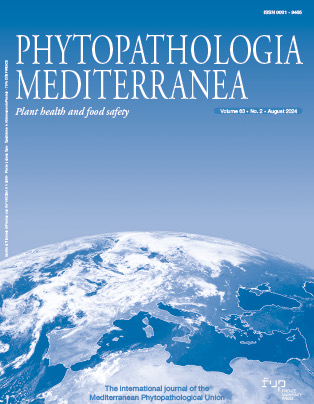Detection of hibiscus chlorotic ringspot virus, citrus exocortis viroid and citrus viroid VI in China rose from Italy using high-throughput sequencing
Published 2024-09-16
Keywords
- HCRSV,
- CEVd,
- CVd-VI,
- mixed infections,
- NGS
How to Cite
Copyright (c) 2024 Giuseppe PARRELLA, Chantal FAURE, Armelle MARAIS, Elisa TROIANO, Thierry CANDRESSE

This work is licensed under a Creative Commons Attribution 4.0 International License.
Abstract
In Spring 2024, a symptomatic plant of China rose (Hibiscus rosa-sinensis) showing leaf yellowing and deformation, located in the province of Naples (South Italy), was re-sampled for further investigations. Total RNAs were purified from leaves and subjected to Illumina HTS analysis. Results confirmed that the plant was infected by hibiscus chlorotic ringspot virus (HCRSV), citrus exocortis viroid (CEVd), and citrus viroid VI (CVd-VI). The two viroids had not been previously detected in China rose. HTS results were confirmed by RT-PCR in the re-sampled plant, and in three nearby China rose plants with the same symptoms, using specific primer pairs for the three pathogens, followed by Sanger sequencing and BLAST analysis of the sequences. Different results obtained can be due to differing sensitivity and specificity in HTS-based detection of plant viruses. This is the first report of multiple infections by HCRS, CEVd and CVd-VI in China rose, which is also a new host for both of the viroids.
Downloads
References
- Abualrob A., Alabdallah O., Kubaa R.A., Naser S.M., Alkowni R., 2024. Molecular detection of Citrus exocortis viroid (CEVd), Citrus viroid-III (CVd-III), and Citrus viroid-IV (CVd-IV) in Palestine. Scientific Report 14: 423. DOI: https://doi.org/10.1038/s41598-023-50271-5
- Cao M., Wu Q., Yang F., Wang X., Li R., Zhou C., Li Z., 2017. Molecular characterization and phylogenetic analysis of Citrus viroid VI variants from citrus in China. European Journal of Plant Pathology 149: 885–893. DOI: https://doi.org/10.1007/s10658-017-1236-3
- De Stradis A., Parrella G., Vovlas C., Ragozzino A., 2008. Vein yellowing of Hibiscus rosa-sinensis caused by Eggplant mottled dwarf virus in southern Italy. Journal of Plant Pathology 90: 359–361.
- Di Gaspero G., Radovic S., De Luca E., Spadotto A., Magris G., … Marroni F., 2022. Evaluation of sensitivity and specificity in RNA-Seq-based detection of grapevine viral pathogens. Journal of Virological Methods 300: 114383. DOI: https://doi.org/10.1016/j.jviromet.2021.114383
- Luigi M., Manglli A., Tomassoli L., Faggioli F., 2013. First report of Hop stunt viroid in Hibiscus rosa-sinensis in Italy. New Disease Report 27: 14. DOI: https://doi.org/10.5197/j.2044-0588.2013.027.014
- Kumar S., Stecher G., Li M., Knyaz C., Tamura K., 2018. MEGA X: molecular evolutionary genetic analysis across computing platform. Molecular Biology and Evolution 35: 1547–1549. DOI: https://doi.org/10.1093/molbev/msy096
- Parrella G., Mignano A., 2024. First report of hibiscus chlorotic ringspot virus infecting Hibiscus rosa-sinensis in Italy. Plant Disease 108: 828. DOI: https://doi.org/10.1094/PDIS-12-23-2699-PDN
- Pourrahim R., Ghobakhlo A., Farzadfar S., 2013. Biological and molecular detection of Hibiscus chlorotic ringspot virus infecting Hibiscus rosa-sinensis in Iran. Phytopathologia Mediterranea 52: 528–531.






